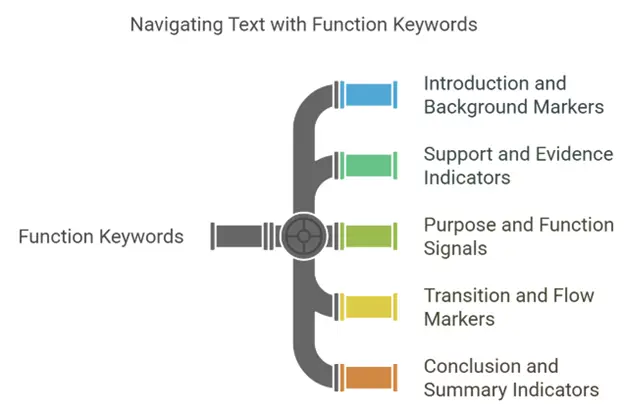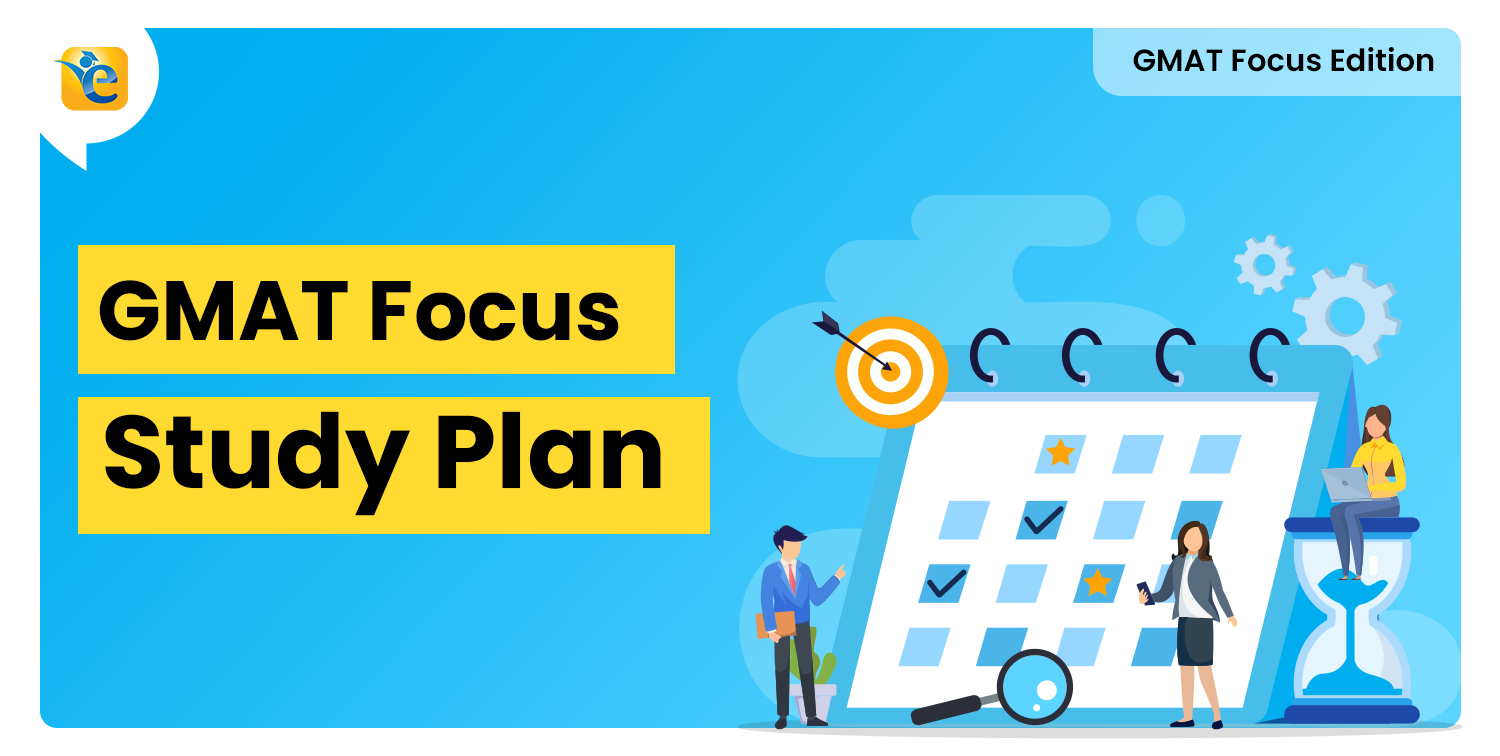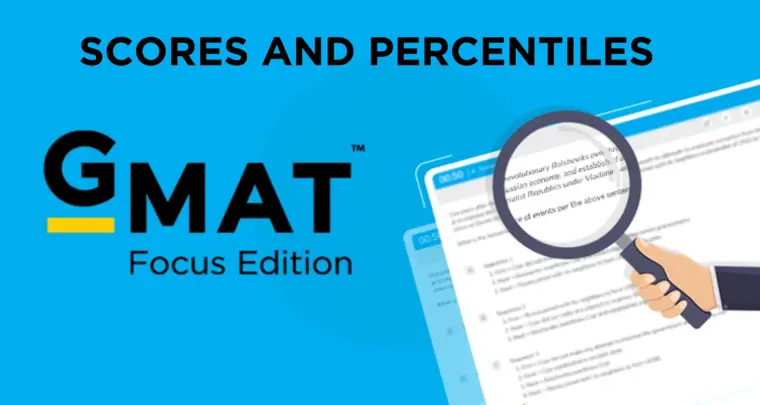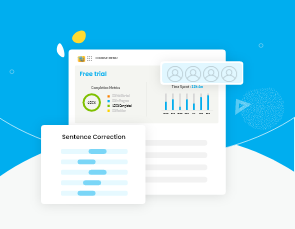In the sophisticated world of GMAT reading comprehension, understanding what information does rather than just what it says is often the key to mastery. Function and purpose keywords are the architectural blueprints of complex passages, revealing the strategic intent behind each paragraph, example, or statement. These linguistic indicators expose the structural backbone of arguments, showing you whether information serves to introduce, support, contrast, conclude, or qualify the author’s points. Like an expert decoder examining a complex blueprint, recognizing these functional markers transforms your reading experience from merely absorbing content to understanding its deliberate design, ensuring you grasp not just what is being communicated, but why it matters and how it advances the author’s objectives.
FUNCTIONS AND PURPOSE KEYWORDS
Function and purpose keywords act as signposts that indicate the role specific information plays within a passage. They help you understand why certain information is included and how different parts of the text relate to the author’s overall argument or narrative.
Function and purpose keywords act as signposts that indicate the role specific information plays within a passage. They help you understand why certain information is included and how different parts of the text relate to the author’s overall argument or narrative.
Types of Function Keywords
Introduction and Background Markers
- Signal the beginning of topics or provide context
- Examples: “Initially,” “To begin with,” “Historically,” “Traditionally,” “As background”
- Function: Set the stage for the main discussion
- Usage note: Often found in opening paragraphs or before new subtopics
Support and Evidence Indicators
- Signal justification or proof for claims
- Examples: “For instance,” “To illustrate,” “Evidence suggests,” “Research indicates,” “As demonstrated by”
- Function: Strengthen arguments with supporting information
- Usage note: Usually follow assertions or claims that need substantiation
Purpose and Function Signals
- Explicitly state why information is included
- Examples: “In order to,” “Designed to,” “Serves to,” “Functions as,” “To this end”
- Function: Clarify the role of information or actions
- Usage note: Help identify the strategic purpose of examples or explanations
Transition and Flow Markers
- Signal movement between ideas or aspects
- Examples: “Furthermore,” “Additionally,” “Meanwhile,” “In contrast,” “Nevertheless”
- Function: Guide readers through logical progression
- Usage note: Help track the development of complex arguments
Conclusion and Summary Indicators
- Signal final points or synthesis of ideas
- Examples: “Therefore,” “Consequently,” “In conclusion,” “Thus,” “Ultimately”
- Function: Indicate where author is drawing inferences or concluding thoughts
- Usage note: Often introduce the most important takeaways
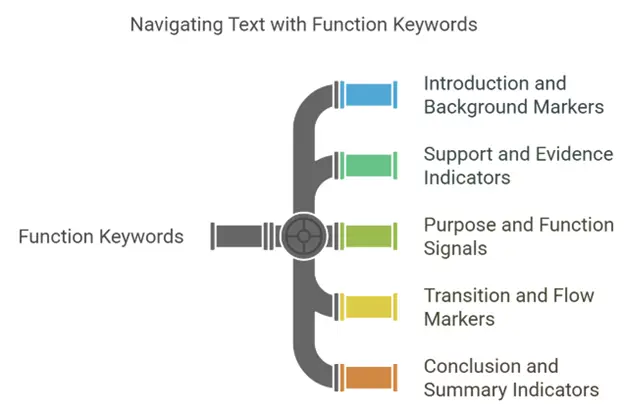
How to Use Function Keywords Effectively
Mapping Passage Structure
- Use introduction markers to identify the setup
- Follow support indicators to find evidence
- Note transition markers to track shifts in perspective
- Identify conclusion indicators to find key takeaways
Predicting Question Types
- Passages with many support indicators often have evidence-based questions
- Texts with clear purpose signals may have function questions
- Passages with strong conclusion markers often have inference questions
Understanding Author Intent
- Function keywords reveal the strategic purpose of information
- Help distinguish between main arguments and supporting details
- Expose the logical structure underlying complex passages
Practice Example
Consider this passage excerpt: “Traditionally, economic models have assumed rational decision-making by market participants. In recent years, however, behavioral economics has challenged this view. For instance, studies of investor behavior reveal systematic deviations from rationality. This research serves to highlight the role of psychological factors in economic decisions. Furthermore, these findings suggest practical applications for policy makers. Therefore, incorporating behavioral insights into economic theory provides a more complete understanding of market dynamics.”
Function keywords tell us:
- “Traditionally” → Introduces the background/conventional view
- “However” → Signals a contrast or shift to a different perspective
- “For instance” → Indicates supporting evidence will follow
- “Serves to” → Explicitly states the purpose of the research
- “Furthermore” → Adds another related point building on previous information
- “Therefore” → Signals the conclusion or key takeaway
Key Takeaways
Recognize the Architectural Role of Function Keywords
Function keywords are not merely transitions—they are deliberate signals of the structural elements within a passage. Learning to identify these keywords reveals the blueprint of the author’s argument, showing how each piece of information serves a specific purpose in the overall design.
Use Function Keywords to Predict Questions
GMAT questions often target the purpose of specific paragraphs or examples. By recognizing function keywords, you can anticipate these questions and quickly locate the relevant information in the passage.
Develop a Structural Reading Approach
Train yourself to notice function keywords as you read, mentally categorizing information according to its role: Is this background? Evidence? A conclusion? This structural awareness transforms passive reading into active comprehension.
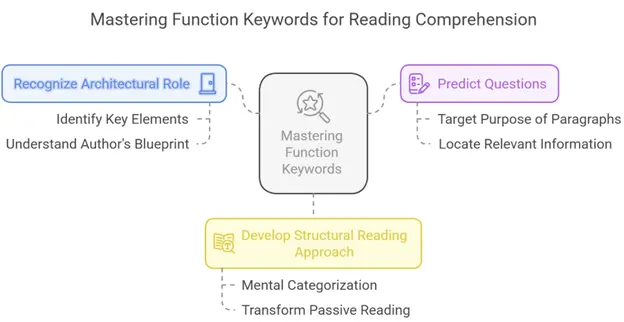
Conclusion
Mastering function and purpose keywords elevates your reading comprehension from merely understanding content to grasping the strategic architecture of complex passages. These linguistic tools reveal the author’s blueprint—showing exactly how and why information is being presented. By developing sensitivity to these functional markers, you gain insight into the deliberate design of arguments, making it easier to navigate complex texts, anticipate questions, and identify key takeaways. For the GMAT test-taker, this skill transforms the reading experience from a potentially overwhelming flood of information into a logical progression of clearly defined elements, each with its own identifiable purpose. As you continue to refine this skill, you’ll find yourself not just reading passages, but decoding their underlying structure with precision and confidence.
Test Your Understanding
“Traditionally, economic models have assumed rational decision-making by market participants. In recent years, however, behavioral economics has challenged this view. For instance, studies of investor behavior reveal systematic deviations from rationality. This research serves to highlight the role of psychological factors in economic decisions. Furthermore, these findings suggest practical applications for policy makers. Therefore, incorporating behavioral insights into economic theory provides a more complete understanding of market dynamics.”
What is the function of the sentence beginning with “For instance”?
a) To introduce the main topic of the passage
b) To provide evidence supporting the challenge to traditional economic models
c) To contrast different economic theories
d) To conclude the passage’s argument
Solution: The correct answer is b, as “For instance” signals that supporting evidence for the challenge mentioned in the previous sentence will follow.


